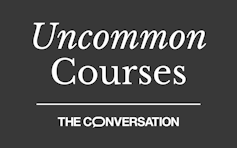Good feedback is an art – here’s how I teach it
Giving and receiving criticism can be difficult. This class tries to make it easier.


Uncommon Courses is an occasional series from The Conversation U.S. highlighting unconventional approaches to teaching.
Title of Course:
“Feedback Loops: How to Give and Receive High-Quality Feedback”
What prompted the idea for this course?
Given that my students pursue careers in an incredibly wide range of fields – business, philanthropy, sports, medicine, finance, human rights, education – I wanted to teach them skills that could serve a general purpose. Being able to give and receive high-quality feedback will help them and the people they work with wherever they end up.
What does the course explore?
We learn how to solicit and deliver feedback. But we also learn how to interpret feedback, particularly when receiving it from multiple sources.
We also experiment with a wide range of feedback frameworks. A few frameworks come from external sources, such as “Radical Candor” by corporate management coach Kim Scott and “Thanks for the Feedback” by Douglas Stone and Sheila Heen of Harvard University’s Negotiation Project. The rest of the frameworks are the product of collaborations with students, lawyers, doctors, consultants and entrepreneurs. These include strategies for how to give your boss feedback, how to receive feedback from a peer and how to process feedback even when it isn’t clear or consistent.
Explain the idea of a framework for feedback
Stone and Heen write about three:
- Appreciation: applauding someone’s effort and performance
- Coaching: showing someone a better way to do something
- Evaluation: telling someone where they stand
The optimal mix varies by person and situation, so we discuss different scenarios when one piece or another should be emphasized. Beginners or someone who is discouraged may need more appreciation, but a more advanced person may crave “coaching” and “evaluation.” That is, a pro baseball player may want tips on improving their swing.
What are some critical lessons from the course?
Just because you are ready to give someone feedback doesn’t mean they are ready to receive it. The comedian Craig Ferguson has said it took him two failed marriages to learn that lesson. He now asks himself three questions before volunteering his thoughts:
- Does this need to be said?
- Does this need to be said by me?
- Does this need to be said by me right now?
Another key idea comes from cognitive psychologist LeeAnn Renninger who explained in a TED Talk the importance of timing. Rather than blindsiding people with criticism, she suggests offering them some control over the delivery. Start by saying something like, “Do you have time to talk about how that last presentation went?”
Consent and autonomy can be critical feedback ingredients.
What materials does the course feature?
Last year, I put the main concepts and exercises from the course into a book called “Feedback Loops: How to Give and Receive High-Quality Feedback” that people can read or download for free. I also use videos, quizzes and assignments from an online course for which the book is a companion text.
What will the course prepare students to do?
Many students say the course helped them become better editors. Others have said it has helped them become better listeners and leaders. Perhaps the biggest benefit, however, is that they develop a set of tools and a conceptual vocabulary that helps them become better at getting better. They learn how to improve the way they – and others – improve.
Patrick Barry does not work for, consult, own shares in or receive funding from any company or organization that would benefit from this article, and has disclosed no relevant affiliations beyond their academic appointment.
Read These Next
New materials, old physics – the science behind how your winter jacket keeps you warm
Winter jackets may seem simple, but sophisticated engineering allows them to keep body heat locked in,…
Deepfakes leveled up in 2025 – here’s what’s coming next
After a year of fast advances, deepfakes are entering a new era defined by real-time interaction with…
As DOJ begins to release Epstein files, his many victims deserve more attention than the powerful me
Powerful men connected to Jeffrey Epstein are named, dissected and speculated about. The survivors,…






